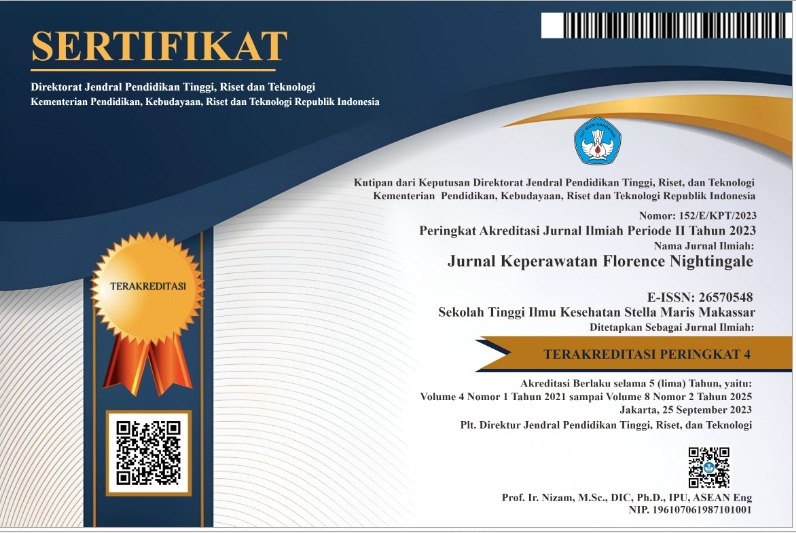The Relationship Between Healthy Lifestyle Behavior and Stroke Risk
Keywords:
Healthy lifestyle, stroke risk, non-communicable diseasesAbstract
Controlling one of the non-communicable diseases, namely stroke, can be done by practicing a CERDIK healthy lifestyle which is one of the important keys in implementing a healthy life. The purpose of this study was to analyze the relationship between healthy lifestyle behavior and the risk of stroke. This type of research uses a quantitative design cross sectional study approach. The population in this study were adults and the elderly in the working area of the Mamasa Health Center, West Sulawesi with 60 respondents selected using non-probability sampling technique accidental sampling approach. This study used the Healthy Lifestyle questionnaire by conducting validity and reliability tests and also using a stroke risk screening questionnaire. This study was tested using SPSS version 25 using chi square and the results obtained p=0.001 which means there is a relationship between CERDIK healthy lifestyle and the risk of stroke. Therefore, it is very important for the community to apply CERDIK healthy lifestyle behaviors to prevent stroke events so as to avoid non-communicable diseases so that the quality of life increases and a healthy community is realized.
Downloads
References
Alchuriyah, S., & Wahjuni, C. U. (2016). Faktor Risiko Kejadian Stroke Usia Muda pada Pasien. Jurnal Berkala Epidemiologi, 4(1), 62–73. https://doi.org/10.20473/jbe.v4i1.62-73
Amila, Sinaga, J., & Sembiring, E. (2018). Pencegahan Stroke Berulang Melalui Pemberdayaan Keluarga Dan Modifikasi Gaya Hidup. Jurnal Abdimas LPM Universitas Negeri Semarang, 22(2), 143–150. https://journal.unnes.ac.id/nju/index.php/abdimas/article/view/15808/8749
Amila, Sinaga, J., & T.Purba, B. (2015). IbM Deteksi Dini Pre Hospital Stroke dan Modifikasi Gaya Hidup Pada Masyarakat Kecamatan Medan Helvetia. https://docplayer.info/35392906-Deteksi-dini-pre-hospital-stroke-dan-modifikasi-gaya-hidup-pada-masyarakat-kecamatan-medan-helvetia.html
Andriana, Y. (2017). Determinan Perilaku ‘Cerdik’ sebagai Upaya Pencegahan Penyakit Tidak Menular pada Masyarakat Peserta Posbindu PTM. https://repository.unej.ac.id/bitstream/handle/123456789/85216/Yayuk Andriana S. - 122110101023_.pdf?sequence=1&isAllowed=y
Anita, F., Rahayu, E., Carolina, Y., Sampe, A., & Ganut, F. (2021). Efektivitas Perilaku Cerdik Dan Patuh Cegah Stroke Berulang. Jurnal Ilmu Keperawatan Medikal Bedah, 4(1), 1–12. https://doi.org/10.32584/jikmb.v4i1.779
Direktorat P2PTM. (2019). Buku Pedoman Penyakit Tidak Menular. Kementerian Kesehatan RI, 101. http://p2ptm.kemkes.go.id/uploads/VHcrbkVobjRzUDN3UCs4eUJ0dVBndz09/2019/03/Buku_Pedoman_Manajemen_PTM.pdf
Kemenkes RI. (2018). Stroke Dont Be The One (p. 10).
Kemenkes RI. (2019). Hasil Riset Kesehatan Dasar Tahun 2018. Kementrian Kesehatan RI, 53(9), 1689–1699.
KemenKes RI. (2016). PTM Pencegahan dan Pengendalian Penyakit Tidak Menular di Indonesia (p. 10). http://p2ptm.kemkes.go.id
Kusuma, D. K. (2011). Metodologi Penelitian Keperawatan. Trans Info Media.
Nurlan, F. (2020). Analisis Survival Stroke Berulang Menurut Umur Dan Jenis Kelamin Pasien Stroke Di Kota Makassar. The Indonesian Journal of Health Promotion, 3(1), 155–161.
Paciaroni, M., & Acciarresi, M. (2019). Poststroke Fatigue. Stroke, 50(7), 1927–1933. https://doi.org/10.1161/STROKEAHA.119.023552
Rika Diah Pitaloka, & Kariasa, I. M. (2021). Rehabilitasi Latihan Fisik Terhadap Pemulihan Pasca Stroke. 5(March), 1–19.
Sugiyono. (2014). Metode Penelitian kuantitatif kualitatif dan r&d. intro ( PDFDrive ).pdf. In Bandung Alf (p. 143).
Sutoni, A., & Cahyati, A. Y. (2021). Penyuluhan Pengaturan Pola Hidup Sehat dalam Upaya. Ikraith-Abdimas, 4(1), 8–18.
Published
How to Cite
Issue
Section
Copyright (c) 2024 Fransiska Anita Ekawati Rahayu Sa'pang, Mery Solon, Matilda Martha Paseno

This work is licensed under a Creative Commons Attribution-ShareAlike 4.0 International License.









